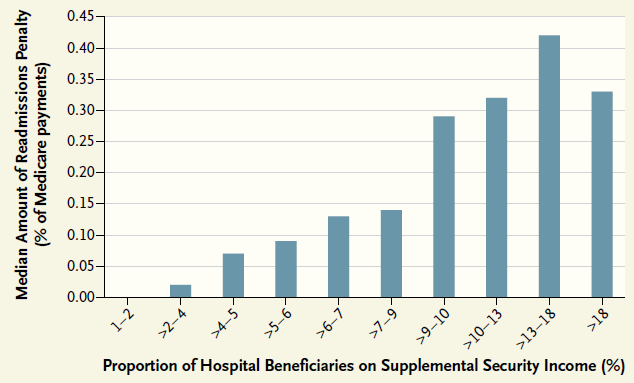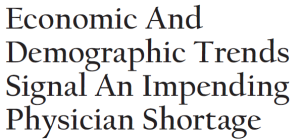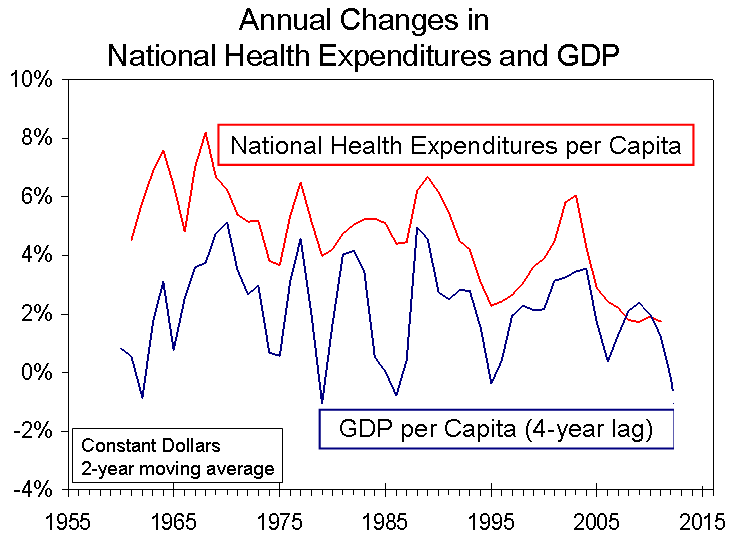Why does the US spend so much on health care, and what is (and is not) being done about it. The answer to “why” is embedded in a narrative that goes something like this: The US spends twice as much as other rich countries, yet its outcomes are among the poorest. This is partly due to higher prices and administrative costs but mainly to “America’s distorted fee-for-service system that rewards quantity over quality and creates a gigantic incentive for inefficiency and waste.” The Institute of Medicine estimates this waste at about 30% of health spending—$750 billion.
Waste has become the mantra of healthcare reform, and it is one of the few issues upon which Republicans and Democrats agree. Indeed, sitting across the table from each other on Fareed Zacharia’s Sunday morning show on Dec 23, Glen Hubbard, a voice of the right, and Peter Orszag, a voice on the left, agreed. The US budget would never be balanced without entitlement reform, and the major reform will have to be in Medicare, and the major problem in Medicare is “waste,” so there’s a lot hanging on this narrative.
Having identified “waste” as the principal cause of high healthcare spending, policy experts have mounted a “war on waste.” In waging this war, Republicans look principally to market forces, while Democrats look to the Affordable Care Act (ACA). According to the Brookings Institution health economist Henry Aaron, the ACA includes “virtually every cost-control idea that anyone has come up with.” Their intent is to redirect care from high-cost specialists to low-cost primary care physicians; reorganize care into medical homes and accountable care organizations; restructure reimbursement from fee-for-service to value-based purchasing and bundled payments; and utilize incentives and penalties to incentivize providers to attain quality benchmarks, adhere to designated clinical guidelines, reduce hospital readmissions, adopt electronic health records and counsel patients concerning certain preventable conditions. This entire portfolio is supported by an expansive regulatory framework and subject to future actions by an Independent Payment Advisory Board.
The ostensible goals of the “War” are to shift the emphasis from volume to value and reduce the growth of spending. Yet few of the “cost-control ideas” were validated before being adopted, and recent studies indicate that few are achieving their stated purposes. Indeed, some have added costs with no parallel benefit. Nonetheless, providers feel they must respond, and they are rechanneling their efforts from identifying innovative solutions to satisfying regulatory standards.
Whether or not the ACA’s cost-saving goals are achieved, the “war” will decisively move the locus of control from physicians to regulators and administrators. As Berwick predicted, “no longer will physicians, paternalistically committed to their patients, be the driving force in medical care. Health care has become an industry, with numerous loci of authority well beyond the doctor’s office.”
It is not difficult to identify wasteful practices. Indeed, addressing them is a continuing professional responsibility. The question is whether they account for as much as 30% of healthcare spending. While several authoritative “guesstimates” claim they do, the quantitative basis for believing so comes from studies of geographic variation in healthcare by Dartmouth Atlas researchers, who identified a portion of the variation that is “unexplained,” attributed it to waste and inefficiency and pegged it at 30% of spending. Although widely cited, these studies are deeply flawed. Indeed, in an op-ed in the Washington Post, I warned that the Dartmouth Atlas was the “wrong map for healthcare reform.”
What, then, explains the “unexplained” variation? The answer resides in population health. It is well known that disease prevalence is greatest among individuals who are poor, poorly educated, often minorities and usually residing in densely poor neighborhoods. It should not be surprising that healthcare utilization among them is much greater than within more affluent populations. Yet their outcomes are poorer. And because poverty is geographic, their increased utilization follows geographic patterns.
Like Milwaukee and Los Angeles, which my colleagues and I described previously, Manhattan is a good example of the impact of poverty. Because healthcare utilization in Manhattan is among the nation’s highest, it is seen as wasteful and inefficient. But Manhattan is a patch-quilt of low and high-income neighborhoods. Utilization in the low-income Bowery is double the rate of the affluent Upper East and Upper West Sides, and utilization in Harlem, the poorest area, is more than triple. Without either, hospital utilization in Manhattan is among the lowest in the nation, lower even than Grand Junction, Colorado, whose healthcare system was held out by President Obama as a model for the nation. But like Grand Junction, the Upper East and West Sides of Manhattan have few African-Americans and no poverty ghettos.
How much does the extra care in poor neighborhoods add to the overall utilization costs within a region? Our studies indicate that it adds about 20% to 25%. Yet, tragically, this fact is ignored—indeed, denied. For example, Dartmouth researchers mockingly note that “some physicians believe their hospitals or regions spend more because their patients are sicker and poorer” and declare, “regional differences in poverty explain almost none of the variation.” In like manner, Nicholas Kristof, a columnist for The New York Times and generally an advocate for the poor, labeled as “opponents of health care reform” those who attributed poor outcomes to America’s large underclass. In fact, poverty explains virtually all of the regional differences in utilization, and “America’s large underclass” accounts for virtually all of the differences in outcomes between the US and other nations.
Real healthcare reform would address these socioeconomic realities. Instead, the US is waging a regulatory “War” on exaggerated measures of waste, one that shows little promise of reducing costs or increasing quality but that will assuredly crush needed innovation by practicing physicians, who best understand the delivery of care. Moreover, because there are no risk adjusters for poverty, physicians whose low-income patients fail to meet federal utilization and quality norms will suffer financially, and hospitals whose poor patients have high readmission rates will be penalized. All the while, the “War on Waste” will distract policymakers from building the social infrastructure that could lower the high healthcare costs of poverty. These are no ordinary times. For the first time, physicians and their patients are caught in the cross-hairs of a “War on Waste.”
(This blog post is taken from Cooper, “The War On Waste,” Oncology, November 15, 2012)

 Isn’t it time to stop this foolishness about geographic variation being a manifestation of variation in practice? Wouldn’t it have been wonderful if that could have occurred before all of the foolish incentives and penalties were written into Obama-care? Shouldn’t someone be held accountable for deceiving congress, distorting the practice of medicine and bilking the profession? Isn’t it time that the high health care costs of poverty became a focus of national attention? Don’t we owe our children a health care system that they can sustain? Won’t it take honest, critical research (like Reschovsky’s) to get us there?
Isn’t it time to stop this foolishness about geographic variation being a manifestation of variation in practice? Wouldn’t it have been wonderful if that could have occurred before all of the foolish incentives and penalties were written into Obama-care? Shouldn’t someone be held accountable for deceiving congress, distorting the practice of medicine and bilking the profession? Isn’t it time that the high health care costs of poverty became a focus of national attention? Don’t we owe our children a health care system that they can sustain? Won’t it take honest, critical research (like Reschovsky’s) to get us there?








